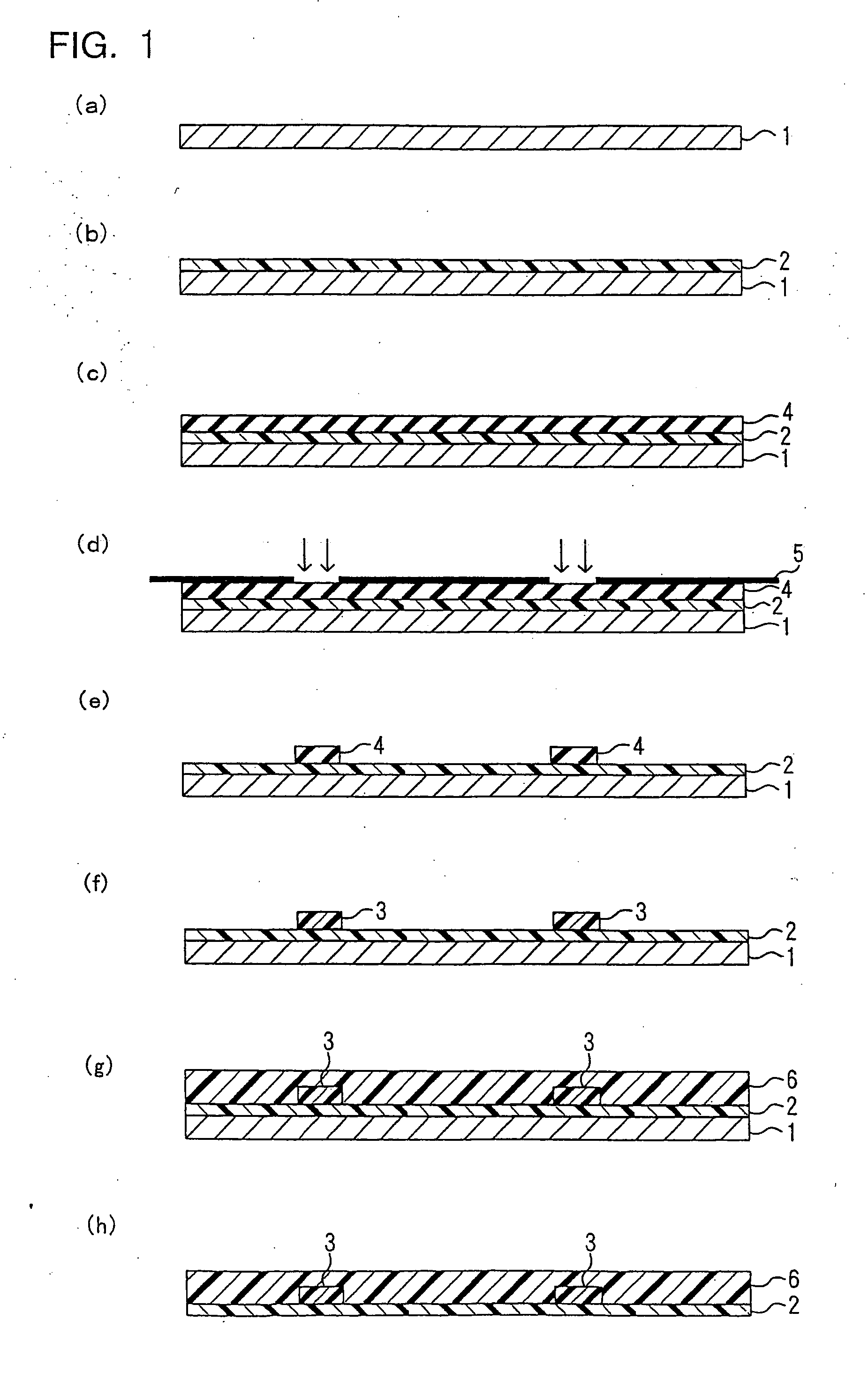Optical waveguide and production method thereof
a technology of optical waveguides and production methods, applied in the field of optical waveguides, can solve the problems of difficult to provide increased production efficiency, and the inability to define the optical waveguide between them in a stable form, so as to reduce the number of processes and time-consuming and complicated works involved in the interposition of spacers, reduce the contamination of the photo mask, and increase production efficiency
- Summary
- Abstract
- Description
- Claims
- Application Information
AI Technical Summary
Benefits of technology
Problems solved by technology
Method used
Image
Examples
example 1
[0097] A substrate wherein an aluminum layer having a thickness of 20 nm was formed on a 10 cm×10 cm glass substrate by a vacuum deposition method was prepared(Cf FIG. 1(a)).
[0098] The varnish A was coated over the substrate by the spin coat method and then dried at 90° C. for 15 minutes, to form a resin layer. Thereafter, the whole area of the resin layer was irradiated with ultraviolet irradiation of 2,000 mJ / cm2 and then heated at 170° C. for 30 minutes, to form an under clad layer having a thickness of 30 μm (Cf. FIG. 1(b)).
[0099] Sequentially, the varnish B was coated over the under clad layer by the spin coat method and then dried at 90° C. for 15 minutes, to form a resin layer (Cf FIG. 1(c)). Then, the resin layer was irradiated with ultraviolet irradiation of 2,000 mJ / cm2 via a photo mask (an artificial quartz-based chromium mask) on which a linear optical waveguide pattern of 50 μm wide was depicted (Cf. FIG. 1(d)). At this time, the photo mask was put into direct contact...
example 2
[0105] Except that the varnish C was used as substitute for the varnish A, the same operation as in Example 1 was performed to form an under clad layer having a thickness of 30 μm on the substrate.
[0106] Sequentially, except that the varnish D was used as substitute for the varnish B, the same operation as in Example 1 was performed to form a core layer having a square-shaped section of 501 μm thick and 50 μm wide on the under clad layer.
[0107] At this time of exposure, the photo mask was put into direct contact with the resin layer, but no adhesion of the resin to the photo mask was found after the exposure of the resin layer to light.
[0108] Thereafter, except that the varnish C was used as substitute for the varnish A, the same operation as in Example 1 was performed to form an over clad layer having a thickness of 80 μm. A multi-mode optical waveguide having a specific refractive index Δ of 3.0% was produced in the manner described above.
[0109] The substrate was not removed. ...
example 3
[0110] A 4-inch silicon wafer was prepared as the substrate, first. Then, the varnish E was coated over that substrate by the spin coat method and then was dried at 90° C. for 15 minutes, to form the resin layer. Thereafter, the whole area of the resin layer was irradiated with ultraviolet irradiation of 2,000 mJ / cm2 and then heated at 170° C. for 30 minutes, to form an under clad layer having a thickness of 10 μm.
[0111] Sequentially, except that the varnish F was used as substitute for the varnish B and the width of the pattern of the photo mask was changed to 6 μm, the same operation as in Example 1 was performed to form a core layer having a square-shaped section of 6 μm thick and 6 μm wide on the under clad layer.
[0112] At this time of exposure, the photo mask was put into direct contact with the resin layer, but no adhesion of the resin to the photo mask was found after the exposure of the resin layer to light.
[0113] Thereafter, except that the varnish E was used as substitu...
PUM
| Property | Measurement | Unit |
|---|---|---|
| thickness | aaaaa | aaaaa |
| carbon number | aaaaa | aaaaa |
| length | aaaaa | aaaaa |
Abstract
Description
Claims
Application Information
 Login to View More
Login to View More - R&D
- Intellectual Property
- Life Sciences
- Materials
- Tech Scout
- Unparalleled Data Quality
- Higher Quality Content
- 60% Fewer Hallucinations
Browse by: Latest US Patents, China's latest patents, Technical Efficacy Thesaurus, Application Domain, Technology Topic, Popular Technical Reports.
© 2025 PatSnap. All rights reserved.Legal|Privacy policy|Modern Slavery Act Transparency Statement|Sitemap|About US| Contact US: help@patsnap.com



